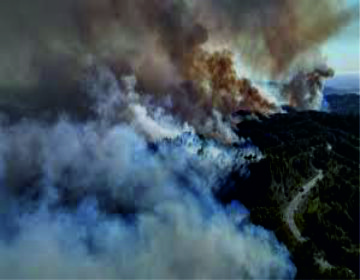


Combating Forest Fires: Strategies, Challenges, and Innovations
Contributed by:
Mr Bharat Parekh
Vice President
Fire Safety Devices Pvt Ltd
Forest fires, also known as wildfires, are among the most destructive natural disasters, causing widespread ecological damage, loss of human life, and economic hardship. With climate change intensifying fire seasons globally, combating forest fires has become more urgent and complex than ever. This article explores the causes of forest fires, methods used to combat them, the challenges involved, and the innovations driving progress in fire management.
Causes of Forest Fires
Forest fires can be triggered by natural or human-induced factors. Natural causes include lightning strikes and prolonged droughts, while human activities such as unattended campfires, discarded cigarettes, arson, and land-clearing practices contribute significantly. Increasing temperatures and reduced rainfall due to climate change further create conditions ripe for ignition and rapid fire spread.
Traditional Fire-fighting Techniques
1. Firebreaks and Controlled Burns
Firebreaks are gaps in vegetation designed to stop or slow the spread of fire. Controlled burns (or prescribed burns) are deliberately set, low-intensity fires used to clear flammable underbrush, reducing the potential fuel for future wildfires.
2. Aerial Support
Helicopters and aircraft drop water or fire retardant chemicals on active fires. These operations are particularly useful in remote or hard-to-reach areas.
3. Ground Crews
Fire-fighters on the ground use hand tools, hoses, and heavy machinery to dig trenches, remove vegetation, and directly combat flames. Their efforts are critical in containing the fire's perimeter and protecting nearby structures.
Technological Advancements
1. Satellite Monitoring and Drones
Satellites and drones provide real-time imagery and thermal data, helping authorities detect new fires early and track their progression. Drones are also used for post-fire assessments and to identify potential flare-ups.
2. AI and Predictive Modeling
Artificial intelligence and machine learning models analyze weather, topography, and vegetation data to predict where fires are likely to occur. This helps allocate firefighting resources more effectively.
3. Smart Sensors and IoT
Ground-based sensors can detect changes in temperature, humidity, and air quality, alerting officials to conditions favorable for fire or indicating a fire’s proximity.
Challenges in Fire-fighting
Despite advances, several challenges persist:
- Climate Change: Warmer temperatures and unpredictable weather patterns lengthen fire seasons and intensify fires.
- Urban Expansion: More people are living near or within forested areas, increasing the risk of ignition and complicating evacuation and protection efforts.
- Limited Resources: Fire-fighting agencies often face budget constraints, aging equipment, and workforce shortages.
- Coordination: Effective fire-fighting requires coordination across local, national, and sometimes international agencies, which can be logistically challenging.
Community Involvement and Prevention
Communities play a vital role in wildfire prevention. Public education campaigns encourage fire-safe practices, such as clearing flammable materials from around homes and obeying fire bans. Programs like “Firewise USA” help neighbourhoods assess and reduce fire risk collectively.
Conclusion
Combating forest fires demands a multi-faceted approach involving prevention, preparedness, rapid response, and technological innovation. As fire seasons grow longer and more severe, collaboration among governments, communities, scientists, and firefighters is essential to safeguard both human life and our natural ecosystems. With continued investment in technology, education, and sustainable land management, we can build resilience against the growing threat of wildfires.
Recent Articles
Combating Forest Fires: Strategies, Challenges, an...
Contributed by:
Mr Bharat Parekh
Vice President
Fire Safety Devices Pvt Ltd
Forest fires, also known as wildfires, are among the most destructive natu...
The Significance of Safety in the Workplace
The Significance of Safety in the Workplace
Contributed by
Mr Rahul Sakhuja
Director
Safety Experts
In today&rsq...
Guardians of Safety: The Vital Role of Flame Detec...
"Guardians of Safety: The Vital Role of Flame Detectors in Industrial Environments"
Contributed By:
Mr. Ashish Shah
CEO, Ambetronics Engineers Pvt. Ltd.
...Protective Footwear: A Crucial Element of Occupati...
Protective Footwear: A Crucial Element of Occupational Safety and Health
Contributed by:
Mr. H. S. Bahety
CEO, Unistar Footwear Pvt. Ltd.
In any w...
Ensuring Fire Safety: The Importance of Testing &a...
Ensuring Fire Safety: The Importance of Testing & Certificationas per Indian Standards
Author: Sandy Dweik, CEO of Thomas Bell-Wright
Fire safet...

